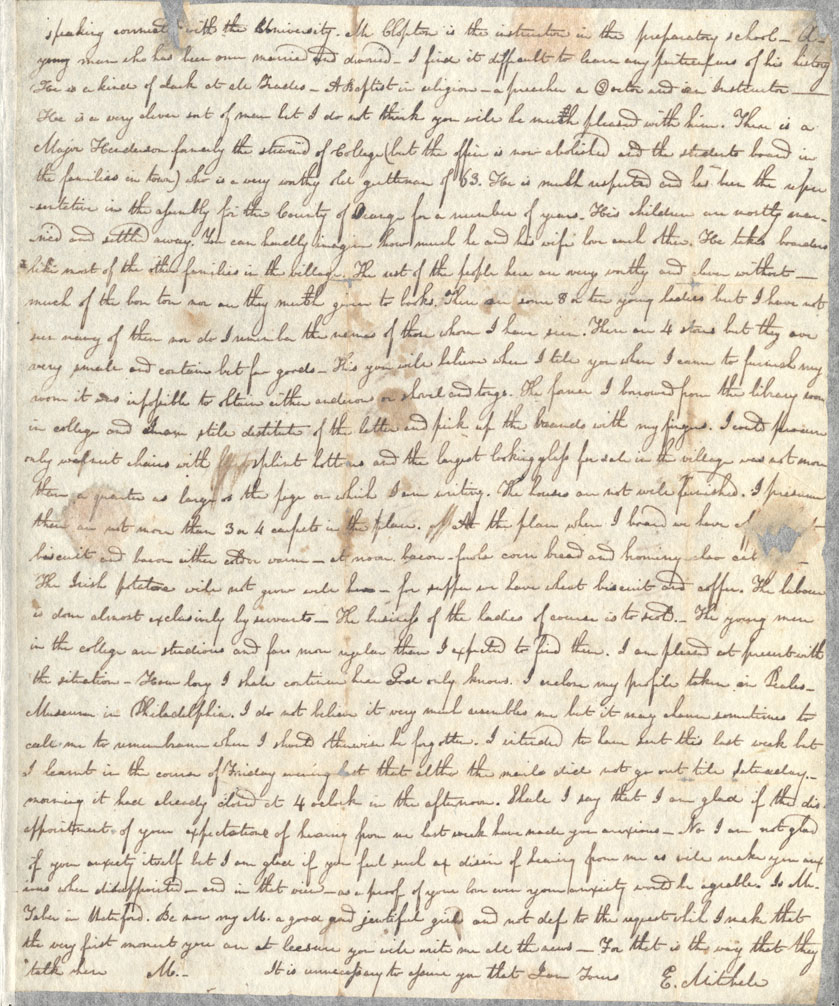
Elisha Mitchell Papers (#518), Southern Historical Collection, University of North Carolina at Chapel Hill
On February 11, 1818, Elisha Mitchel wrote a letter to his fiancé, Maria North to describe the town and the environment surrounding countryside of his new workplace Chapel Hill, NC, where he had just arrived. The record tells that the majority of students were living on campus, 30 students lived in Old East, 51 students in South Building and remaining 28 students lived in 13 different off-campus Chapel Hill homes in 1819 [1] thus we can assume that the situation must have been similar in 1818.
Elisha has drawn a map in his letter telling where he was boarding. In the letter, he lists food that he has eaten at the place he boards. “cof[fee whea]t biscuit and bacon either cold or warm—at noon bacon, fowls corn bread and hominy– also cab[bage]—The Irish potatoe will not grow well here—for supper we have wheat biscuit and coffee.”
Since he was boarding and was not living independently, this list clearly tells the food eaten at Chapel Hill at that time period. In the list, staple food like corn and wheat appears in the form of “fowls corn bread and hominy” and “wheat biscuits”. As for wheat, University has a strong connection since some plantation owner participated in a donation for the university and there were many famous Mills close to the University known for providing excellent quality flour [2]. In the letter, Elisha also points out that Irish potato was not supplied and cabbage was provided. Irish potato is known for growing well in places which receive regular rainfall and cool climate and since Elisha notes that “The irish potatoe will not grow well here” Chapel Hill might not have matched the environment needed to provide Irish potatoes. However, in the bill of fare by the board of trustee in 1808, it is said to provide similar food as Elisha was provided but it also mentions to provide “potatoes and all other kinds of vegetable food usually served up in Carolina.[3]” By considering those two documents, we can assume that potato was transported from a different area of North Carolina and was not harvested in Chapel Hill. Elisha also notes that “The labour is done almost exclusively by servants—The business of the ladies of course is to scold.” This tells that the food in the campus boarding house was made by poorly treated slaves.
This letter is significant not only because it tells the food provided in this time period in Chapel Hill but also because it reveals who was taking part in conveying the food history of the University.
Karin Tsubakihara
________________________________________
[1]”Kemp P. Battle (Kemp Plummer), 1831-1919. History of the University of North Carolina. Volume I: From Its Beginning to the Death of President Swain, 1789-1868.” Booker T. Washington, 1856-1915. An Autobiography. The Story of My Life and Work. Accessed October 09, 2018. https://docsouth.unc.edu/nc/battle1/battle1.html#p273.
[2]Henderson, Archibald. The Campus of the First State University. Chapel Hill, 1949
[3]Universityof North Carolina. “Bill of Fare at Commons at the University of North Carolina for the Year 1808, December 10, 1807: Electronic Edition.” Booker T. Washington, 1856-1915. An Autobiography. The Story of My Life and Work. Accessed October 09, 2018. https://docsouth.unc.edu/unc/unc06-127/unc06-127.html.